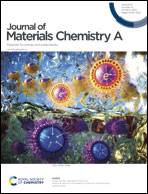Engineering hierarchical Sb2S3/N–C from natural minerals with stable phase-change towards all-climate energy storage†
Abstract
Natural stibnite, as a typical energy-storage material, has triggered a series of active explorations due to its considerable theoretical capacity. However, it still suffers from volume expansion and sluggish kinetics. Herein, with the assistance of lattice regeneration and interfacial engineering, hierarchical Sb2S3 with N-doped carbon is obtained, successfully lowering the diffusion of ions/e− and energy barriers. In addition, the infiltration of electrolyte and the process of physical–chemical reactions are enhanced by the uniform thickness of the carbon layer and rich nanodots. As expected, even at 5.0 A g−1, a considerable capacity of 493.8 mA h g−1 with a retention rate of ∼92% could be retained. Meanwhile, as the temperature was lowered to −10 °C, a remarkable capacity of 366.9 mA h g−1 could still be kept at 1.0 A g−1 with a retention of 90.1% after 100 loops. Supported by “voltage cutting” analysis, the key elements of capacity improvement regarding phase transitions are further determined. Moreover, the detailed analysis of kinetics strongly demonstrated the enhancement of surface-controlling behaviors and the decrease in capacitive resistance. The fading of the reversible reaction and increasing Li2S at low temperature are further confirmed by incomplete phase changes. This work is expected to offer promising prospects for engineering advanced mineral-based energy-storage materials at wide temperatures.



 Please wait while we load your content...
Please wait while we load your content...